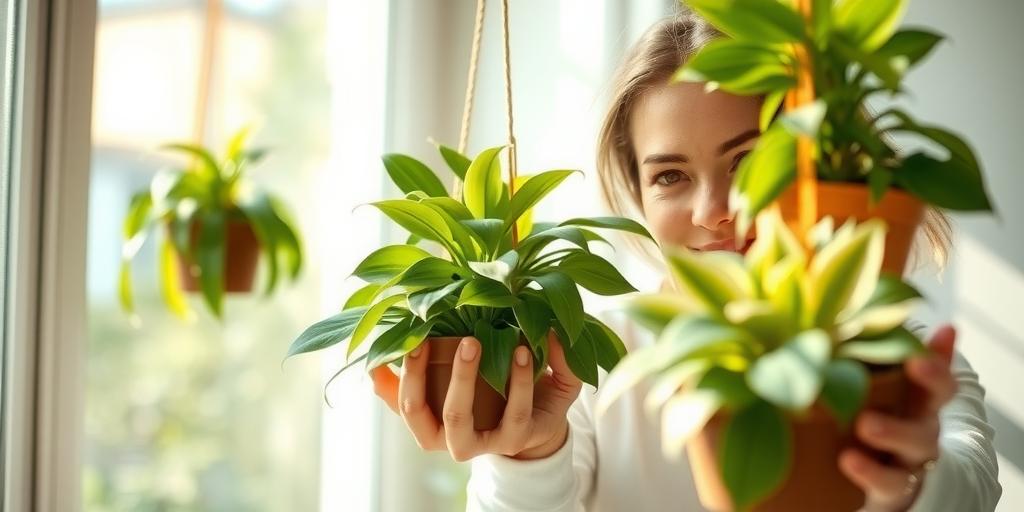
How to Increase Humidity for Low Light Hanging Plants: Essential Care Tips
Learn how to boost humidity for low light hanging plants with these expert care tips! Discover simple methods to keep your plants thriving, even in dim spaces.
Introduction
Did you know that most low light hanging plants originate from tropical environments where humidity levels are high? Without enough moisture in the air, your beloved pothos, ferns, or philodendrons might struggle to thrive. If you’ve noticed crispy leaf edges or slow growth, low humidity could be the culprit. Don’t worry—in this guide, we’ll walk you through easy, effective ways to increase humidity and keep your low light hanging plants lush and healthy. Let’s dive in!
Why Humidity Matters for Low Light Hanging Plants
The Natural Habitat of Popular Low Light Hanging Plants
Many of the most popular low light hanging plants, like pothos, spider plants, and heartleaf philodendrons, originally come from tropical forests. In these environments, they thrive under the dense canopy of trees, where sunlight is filtered and humidity levels are consistently high. The air in these regions is often saturated with moisture, which helps keep their leaves lush and healthy.
When we bring these plants indoors, especially into homes with dry air, they can struggle to adapt. Unlike desert plants, which store water efficiently, tropical plants rely on ambient moisture to stay hydrated. Without enough humidity, they can’t absorb water through their leaves as effectively, leading to stress and poor growth.
How Low Humidity Affects Plant Health
Low humidity can cause several problems for your hanging plants. First, you might notice dry, crispy leaf edges—a classic sign that the air is too dry. Over time, leaves may yellow or drop prematurely. Stunted growth is another common issue, as the plant conserves energy instead of producing new foliage.
Some plants, like ferns and calatheas, are especially sensitive and may wilt or curl their leaves in protest. Even hardy species like pothos will show signs of distress if the air is too dry for too long.
Signs Your Plant Needs More Moisture
How can you tell if your hanging plant is suffering from low humidity? Here are a few key signs to watch for:
-
Browning leaf tips – This is often the first symptom, especially in plants with thin leaves.
-
Drooping or curling leaves – The plant may be trying to reduce moisture loss.
-
Slow growth – If your plant isn’t putting out new leaves as quickly as usual, dry air could be the culprit.
-
Increased pest problems – Spider mites, in particular, thrive in dry conditions and can infest weakened plants.
If you notice any of these issues, it’s time to boost the humidity around your plant.
Best Ways to Increase Humidity for Hanging Plants
Misting: How Often to Mist and the Best Technique
Misting is one of the easiest ways to add moisture to the air around your plants. For best results, use a fine spray bottle filled with room-temperature water. Aim for a light mist rather than soaking the leaves, as too much water can encourage fungal growth.
How often should you mist? It depends on your home’s humidity levels, but a good rule of thumb is 2-3 times a week for most tropical plants. If your air is very dry (like in winter), you might need to mist daily. Just be sure to do it in the morning so the leaves have time to dry before nightfall.
Humidity Trays: Setting Up Pebble Trays Under Hanging Planters
A pebble tray is a simple and effective way to increase humidity. Here’s how to make one:
-
Fill a shallow tray with small pebbles or stones.
-
Add water until it’s just below the top of the pebbles.
-
Place your hanging plant’s pot on top (make sure the pot isn’t sitting directly in water).
As the water evaporates, it creates a humid microclimate around the plant. Just remember to refill the tray as needed—especially in dry weather.
Grouping Plants: Creating a Microclimate by Clustering Plants Together
Plants naturally release moisture through a process called transpiration. When you group several plants together, they create a more humid environment for each other. This is especially helpful for hanging plants placed near each other on a shelf or in a corner.
Try clustering humidity-loving plants like ferns, prayer plants, and philodendrons for the best effect. Just make sure they still have enough airflow to prevent mold or mildew.
Room Humidifiers: Choosing the Right Humidifier for Plant Care
If you have multiple plants or live in an extremely dry climate, a humidifier can be a game-changer. Look for one with adjustable settings so you can control the humidity level (aim for 50-60% for most tropical plants). Ultrasonic humidifiers are quiet and efficient, making them a great choice for plant lovers.
Place the humidifier near your hanging plants, but not so close that water droplets collect on the leaves. Running it for a few hours a day is usually enough to make a noticeable difference.
Bathroom or Kitchen Placement: Utilizing Naturally Humid Spaces
Bathrooms and kitchens tend to have higher humidity levels thanks to showers, sinks, and cooking steam. If you have a window in either of these rooms, consider hanging your plants there. Just make sure they still get enough indirect light—low light doesn’t mean no light!
Choosing the Right Plants for Low Light & High Humidity
Top Low Light Hanging Plants That Love Humidity
Not all plants need the same level of humidity. If you’re looking for low light hanging plants that thrive in moist air, consider these options:
-
Spider Plant – Hardy and adaptable, but appreciates humidity.
-
Heartleaf Philodendron – Tolerates low light and loves moisture.
-
Pothos – One of the easiest plants to grow, but does better with some humidity.
-
Ferns (e.g., Boston Fern, Maidenhair Fern) – These need high humidity to stay lush.
-
Peperomia – Compact and great for small spaces with moderate humidity.
How to Match Plant Needs With Your Home’s Conditions
Before choosing a plant, assess your home’s natural humidity levels. If you live in a dry climate or use air conditioning frequently, opt for more forgiving plants like pothos or spider plants. If you can maintain higher humidity (with a humidifier or pebble trays), you can experiment with fussier species like ferns or calatheas.
Alternatives If Your Space Can’t Maintain High Humidity
If boosting humidity isn’t an option, choose plants that tolerate drier air. ZZ plants and snake plants can handle low light and low humidity, though they won’t grow as quickly. Another option is to use artificial plants if you love the look of hanging greenery but can’t meet the care requirements.
Common Mistakes to Avoid When Raising Humidity
Over-Misting and Risking Fungal Growth
While misting helps, too much can lead to problems like powdery mildew or leaf rot. Avoid misting plants with fuzzy leaves (like African violets) and always allow leaves to dry between sprays.
Placing Plants Too Close to AC Vents or Heaters
Dry air blowing directly on plants will counteract your humidity efforts. Keep hanging plants away from vents, radiators, and drafty windows.
Ignoring Airflow, Leading to Stagnant Moisture
Good air circulation prevents mold and pests. If you’re using a humidifier or grouping plants, ensure there’s some gentle airflow—a small fan can help.
DIY Humidity Hacks for Plant Lovers
DIY Terrariums for Small Hanging Plants
Terrariums create a self-contained humid environment. You can make one using a glass container, some pebbles for drainage, and a small hanging plant like a fern or trailing peperomia. Just open the lid occasionally to let fresh air in.
Using a Spray Bottle With Distilled Water
Tap water can leave mineral deposits on leaves. Using distilled or filtered water in your spray bottle keeps leaves clean and healthy.
Creative Ways to Repurpose Glass Jars or Cloches
If you have a small plant that needs extra humidity, place a glass jar or cloche over it (with some ventilation). This works well for cuttings or delicate plants that need a moisture boost while they acclimate.
By understanding your plants’ needs and using these simple techniques, you can keep your low light hanging plants thriving—even in the driest conditions.
Conclusion
Keeping your low light hanging plants happy doesn’t have to be a challenge! By increasing humidity through simple methods like misting, grouping plants, or using a humidifier, you can recreate their natural environment and prevent common issues like dry leaves. Start with one or two techniques and see the difference it makes. Your plants will thank you with lush, vibrant growth—ready to transform your space into a green oasis!
